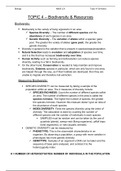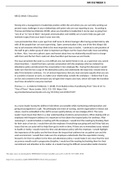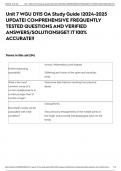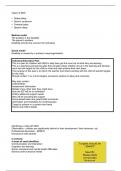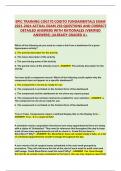Biology Nikhil 12Y Topic 4 Full Notes
TOPIC 4 – Biodiversity & Resources
Biodiversity:
Biodiversity is the variety of living organisms in an area.
Species Diversity – The number of different species and the
abundance of each species in an area.
Genetic Diversity – The variation of alleles within a species’ gene
pool. The greater the variety of alleles (gene pool), the greater the
genetic diversity.
Diversity in general is the variation that is present in species/areas/population.
Natural Selection leads to evolution and adaptation of species over time,
and it is this that has increased biodiversity over time.
Human Activity such as farming and deforestation can reduce species
diversity, leading to a fall in biodiversity.
On the other hand, Conservation is needed to help maintain and improve
biodiversity. Endemic species in particular, which are only found in one area,
are helped through this way, as if their habitats are destroyed, then they are
unable to migrate and therefore risk extinction.
Measuring Biodiversity:
SPECIES DIVERSITY can be measured by taking a sample of the
population within an area. The 2 measures of diversity include:
SPECIES RICHNESS: Count the number of different species within
an area. The number of different species in the area is called the
species richness. The higher the number of species, the greater
the species richness. However this measure doesn’t give an idea of
the abundance of each species.
INDEX DIVERSITY: Finds the species diversity using the index of
diversity. The calculation is done by counting the number of
different species and the number of individuals in each species.
SAMPLES must be random and can be taken by the use of
quadrats (plants), sweep nets (flying organisms), pitfall traps
(land organisms), or nets (aquatic animals).
GENETIC DIVERSITY can be measured by:
PHENOTYPE: This is the observable characteristics in an
organism. By observing a population, a group with more variation in
phenotypes has more genetic diversity.
GENOTYPE: Samples of an organism’s DNA can be taken and the
sequence of base pairs analysed, and contrast it to the
heterozygosity index: f
H = NUMBER OF HETEROZYGOTES/ NUMBER OF INDIVIDUALS IN THE POPULATION
, Biology Nikhil 12Y Topic 4 Full Notes
INDEX OF DIVERSITY can also be used to measure biodiversity as
mentioned before. It measures species diversity (species and the abundance
of them in that area). The greater the result gained from the equation, the
more diverse the area is. The equation is as follows:
Species:
A species can be defined as a group of organisms with similar morphology,
PHYSIOLOGY and BEHAVIOUR, with the ability to interbreed to produce
fertile offspring that are reproductively isolated from other species.
An example of this can be horses and donkeys. They are similar in all 3
categories mentioned above, and also can be bred together to produce
mules, however the mules produced are infertile, thus donkeys and
horses are distinct species.
Modern techniques are now more common for sorting organisms into species,
with the use of DNA analysis. An example of this is the use of DNA barcodes.
Niches:
A Habitat can be defined as the area of which an organism lives. Each habitat
has a particular set of conditions that supports a distinctive combination of
organisms.
Within a habitat, there can be POPULATIONS of organisms. This can be
defined as a group of interbreeding individuals of the same species found in
an area.
The various populations in a habitat compose a COMMUNITY.
An organisms’ ENVIRONMENT provides essential resources such as energy,
raw materials, a place to live, and potential mates.
Naturally, the resources in an environment are limited to some extent,
therefore organisms must compete INTRA and INTERSPECIFICALLY (within
and between species).
Each species within a habitat has a particular NICHE. This can be defined as
the way in which an organism exploits its environment.
Species sharing a habitat have different niches. If there are two or more
species with the same niche, then there will be competition. The BETTER-
ADAPTED species will drive off the less capable.
Niche Examples:
Orchids: Pyramidal orchids produce a scent that attracts moths, which
probe within the orchid. A pollen parcel then attaches itself with quick-

